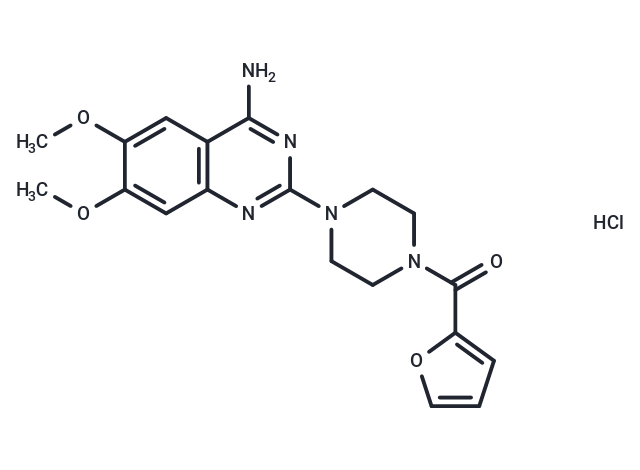Shopping Cart
Remove All Your shopping cart is currently empty
Your shopping cart is currently empty
Prazosin hydrochloride (Vasoflex) reduces peripheral resistance and relaxes vascular smooth muscles as a selective adrenergic alpha-1 antagonist by a mechanism not completely known. Prazosin hydrochloride is a synthetic piperazine derivative with hypotensive antiadrenergic properties, It is used in the treatment of heart failure, hypertension, pheochromocytoma, Raynaud's syndrome, prostatic hypertrophy, and urinary retention.

| Pack Size | Price | USA Warehouse | Global Warehouse | Quantity |
|---|---|---|---|---|
| 25 mg | $30 | In Stock | In Stock | |
| 50 mg | $37 | In Stock | In Stock | |
| 100 mg | $50 | In Stock | In Stock | |
| 500 mg | $113 | In Stock | In Stock | |
| 1 g | $163 | In Stock | In Stock | |
| 1 mL x 10 mM (in DMSO) | $50 | In Stock | In Stock |
| Description | Prazosin hydrochloride (Vasoflex) reduces peripheral resistance and relaxes vascular smooth muscles as a selective adrenergic alpha-1 antagonist by a mechanism not completely known. Prazosin hydrochloride is a synthetic piperazine derivative with hypotensive antiadrenergic properties, It is used in the treatment of heart failure, hypertension, pheochromocytoma, Raynaud's syndrome, prostatic hypertrophy, and urinary retention. |
| In vitro | Prazosin leads to a significant increase in VEGF concentration in endothelial cells and angiogenesis only if eNOS is present. Prazosin binds to the α1-adrenergic receptors that are present on smooth muscle cells surrounding all larger blood vessels. [1] Prazosin (0.1 nM) blocks the increases in perfusion pressure caused by electrical stimulation of the perimesenteric nerves but does not significantly reduce the vasomotor effect of exogenous noradrenaline. [2] |
| In vivo | Prazosin application leads to the expansion of the capillary system by modulation of the hemodynamic environment (flow rate, shear stress) in skeletal muscle. Prazosin induces angiogenesis in extensor digitorum longus (EDL) muscles of C57BL/6 mice but not eNOS-knockout mice. [1] Prazosin (0.5-2.0 mg/kg) blocks Yohimbine-induced reinstatement of food and alcohol seeking, as well as footshock-induced reinstatement of alcohol seeking in rats. [3] Prazosin (0.2 mg kg(-1) s.c.) causes an enhancement of a suppression of conditioned avoidance response in the presence of the dopamine D2 receptor antagonist raclopride (0.05-0.20 mg/kg s.c.) in rats. [4] Prazosin administration alone (1 mg/kg, s.c.) only slightly reduces horizontal activity during an initial 10 min measurement period, although it consistently reduces rearing in freely moving rats. Prazosin effectively suppresses the locomotor stimulation caused by either dose of MK-801 throughout the whole observation period in freely moving rats. [5] |
| Synonyms | Vasoflex, Prazosin hydrochloride, Prazosin HCl, Peripress, Minipress, cp-12299-1 |
| Molecular Weight | 419.86 |
| Formula | C19H22ClN5O4 |
| Cas No. | 19237-84-4 |
| Smiles | COC1=CC2=C(C=C1OC)C(N)=NC(N3CCN(CC3)C(C4=CC=CO4)=O)=N2.Cl |
| Relative Density. | no data available |
| Color | White |
| Appearance | Solid |
| Storage | Powder: -20°C for 3 years | In solvent: -80°C for 1 year | Shipping with blue ice/Shipping at ambient temperature. | ||||||||||||||||||||||||||||||||||||||||
| Solubility Information | Ethanol: 5 mM, Sonication is recommended. DMSO: 55 mg/mL (131 mM), Sonication is recommended. | ||||||||||||||||||||||||||||||||||||||||
| In Vivo Formulation | 10% DMSO+40% PEG300+5% Tween 80+45% Saline: 1 mg/mL (2.38 mM), Sonication is recommended. Please add the solvents sequentially, clarifying the solution as much as possible before adding the next one. Dissolve by heating and/or sonication if necessary. Working solution is recommended to be prepared and used immediately. The formulation provided above is for reference purposes only. In vivo formulations may vary and should be modified based on specific experimental conditions. | ||||||||||||||||||||||||||||||||||||||||
Solution Preparation Table | |||||||||||||||||||||||||||||||||||||||||
Ethanol/DMSO
DMSO
| |||||||||||||||||||||||||||||||||||||||||
| Size | Quantity | Unit Price | Amount | Operation |
|---|

Copyright © 2015-2025 TargetMol Chemicals Inc. All Rights Reserved.